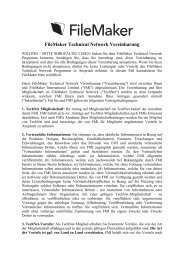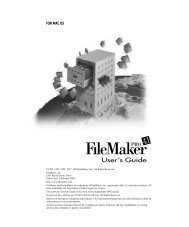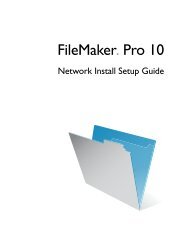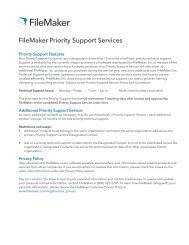FileMaker Security Guide
FileMaker Security Guide
FileMaker Security Guide
You also want an ePaper? Increase the reach of your titles
YUMPU automatically turns print PDFs into web optimized ePapers that Google loves.
<strong>Security</strong> “Top 10” list 13<br />
• Make sure backup copies aren’t damaged or inaccessible. Verify that they are functioning<br />
properly before you need them. Run diagnostic tools on your hard drive and your backup files<br />
regularly.<br />
• Ensure that you can restore an entire set of files from backup copies.<br />
• Regularly export the data to protect against file corruption.<br />
• Protect the backup media itself. Store backups in a separate and fire-proof location.<br />
• Assign backup administrators who can retrieve files, in case the network administrator is<br />
unavailable.<br />
• Plan for redundancy. If the power goes off, a universal power supply (UPS) should sustain power<br />
for at least 15 minutes, enabling you to safely close all files. If the power can’t be restored in a<br />
timely fashion, consider using a generator to supply power to servers. Also consider power<br />
sources for routers and firewalls. Will communication be a problem if your Internet access is<br />
interrupted for 48 hours or longer?<br />
• Consider how you will continue to provide services if an intruder takes down your database<br />
server and that server can’t be restored to its previous condition.<br />
• Evaluate additional scenarios that could occur, and create a plan to respond to each one.<br />
Also, network administrators should assess risks to data systems and business-critical functions.<br />
For example, consider:<br />
• Theft of data or theft of proprietary intellectual property.<br />
• Disruption, theft, or damage to network infrastructure such as servers, networks, data storage, or<br />
data backup storage. Damage can be caused by password crackers or by other types of malicious<br />
sabotage and destruction. Most incidents originate from within the organization.<br />
• Disruption or damage to the organization infrastructure such as building fires, environmental or<br />
biological hazards, floods, and so on.<br />
• Disruption or damage to the public infrastructure, including electrical power,<br />
telecommunications (voice and data), transportation grids (roadways, buses, trains) caused by<br />
environmental conditions, or severe weather such as tornadoes or floods.<br />
Important In the event of a server failure, such as an unexpected loss of power, hard drive failure,<br />
or software failure, use the backup files. Any system failure causing <strong>FileMaker</strong> Server to shut down<br />
inappropriately can result in corrupted files if cached data was not written to disk and the files were<br />
not closed properly. Even if the files re-open and go through a consistency check or recovery,<br />
corruption might be buried in the file. File recovery cannot guarantee that problems have been<br />
fixed.<br />
About <strong>FileMaker</strong> Pro file recovery<br />
Use the recovery feature when a database file is closed inappropriately and the data since the last<br />
backup must be recovered. Recovery creates a new file with a name different than the original file<br />
because it is not intended to replace the file. It is an aggressive process which might remove layouts,<br />
scripts, etc. in order to return the most data possible. The data should be exported from the<br />
recovered file and imported into a clean backup of the original database file.<br />
Because recovery can take a long time, make local backups at an interval relating to the amount of<br />
data that could be lost.

















